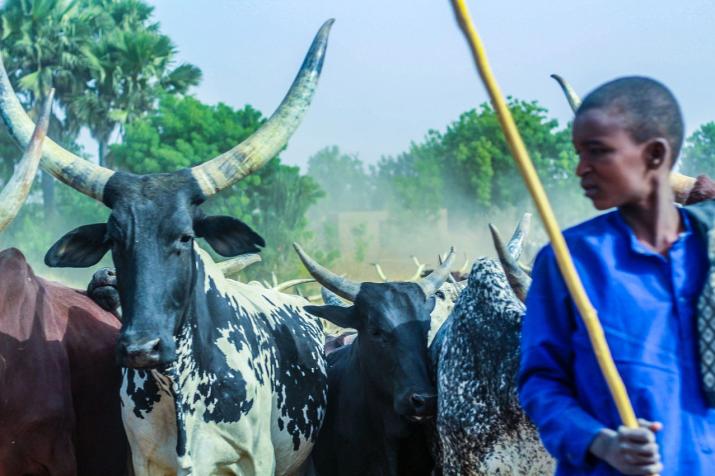
Cattle in Africa, an important source of income for many people, can pass the virus that causes Rift Valley fever on to people who tend them. Photo by Pixabay
Published August 11, 2023 under Research News

Rift Valley fever, a viral infection most commonly seen in livestock and domestic animals in sub-Saharan Africa, doesn’t often show up in humans. But when it does, Deng Madut, M.D., wants to know about it.
One such incident happened in 2018 in northern Tanzania. Researchers from the University of Glasgow detected a Rift Valley viral outbreak in a herd of dairy cattle. But they suspected some of the people handling the animals may have contracted the virus, too. They contacted Madut, an assistant research professor with the Duke Global Health Institute who is based at the Kilimanjaro Christian Medical Centre (KCMC) in Moshi, Tanzania.
At KCMC, Madut is part of a team that investigates the causes of febrile illnesses in the country. The team found the Rift Valley virus in the blood of three people who had contact with infected animals. A fourth person died after being infected, an autopsy confirmed.
“We don’t know the exact mechanisms for how these patients contracted the virus,” says Madut, who is also on the faculty with the Duke School of Medicine. “But we generally know people’s behaviors can cause them to get Rift Valley fever because of close contact with blood of infected animals, or possibly raw milk.”
Those unknowns underscore the importance of paying attention to lesser-known illnesses like Rift Valley fever, Madut says. Fevers in sub-Saharan Africa are often attributed to diseases such as malaria, but they can be caused by a host of bacteria and viruses, many of which can lead to severe illness or death. In humans, a Rift Valley infection can cause hemorrhagic fever, blood loss and organ failure. About 1 percent of people infected die from the illness.
Outbreaks of Rift Valley fever can also have a devastating effect on livestock, an important source of income for many in the region. Based on its potential impacts on both health and economic activity, the World Health Organization in 2017 listed the virus among its top 10 priority pathogens.
“It’s important to think about prevention and how to get toward it because of the potential socioeconomic implications,” Madut says. “These outbreaks can cost millions of dollars if other countries stop trade. It can decimate an economy, and it means losses for the local population.”
In a research paper to be published later this year, Madut and his collaborators argue that incidents such as the 2018 outbreak show the need for more research to better understand Rift Valley fever and how it is transmitted. He has also applied for a grant from the National Institutes of Health to continue that work, which could help accelerate the development of prevention and treatment options. Currently, the only vaccine against Rift Valley is for animals.
But Madut says it’s not just local conditions that motivate the team’s investigations. The COVID-19 pandemic is a stark reminder that a previously unknown virus can quickly emerge as a global threat.
While no human-to-human transmission of the Rift Valley virus has been documented, people can be infected by handling animal tissue or from mosquitoes that have bitten animals with the virus. A 1977 outbreak in Egypt resulted in more than 600 human deaths.
“You never know when there’s going to be a major outbreak, so we need to have pandemic preparedness,” he says.

Based at KCMC, the research team...
Madut first saw the impact of these lesser-known illnesses as a medical student. In 2016, he worked at KCMC as a fellow in the Global Health Pathway Program, through the Duke Hubert-Yeargan Center for Global Health. He noticed many of the fevers and symptoms that brought patients to the hospital were not related to common causes such as HIV or malaria. He came away from the experience facing a professional crossroads.
“I had to make a decision if I wanted to be more of an HIV researcher or study illnesses,” Madut recalls. “We’ve made a lot of advances in areas such as HIV, but there are other diseases less explored.”
But studying less-common pathogens has also showed him how much these illnesses have in common.
“There’s a lot of overlap with how some viruses are transmitted,” he says. “All pathogens need are the right kind of environment, vector and host to survive. We need to study these [lesser-known] infections because we can help out local – and global – populations.”


